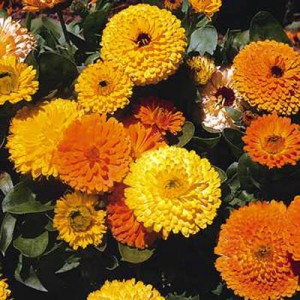
|
|
Marigold (Calendula
officinalis)
|
Calendula
- Marigold (Calendula officinalis)
These are lovely, annual plants native to southern
Europe. They grow 1Ĺ to 2Ĺ feet high. Their branching stems are covered with
simple, alternate leaves and they produce large flowers in different hues of yellow and orange in the
summer. These plants are easy to grow. The main kind is C. officinalis (the Common Pot
Marigold), it has light green leaves and short stems bearing single or
double, orange, yellow, cream, or white flowers that are 2-3 inches
across. These plants are valuable for more than just their beauty.
Calendulas have been grown as garden plants for many years throughout Europe and North
America. The flowers of Calendula officinalis have been used as medicine for
centuries, and the herbal remedies based upon calendula has been known for
generations.
Early Christians called calendula
"Mary's Gold," and placed it by the statues of the Virgin Mary. The most sacred flower of ancient
India, calendula stems and flower heads were strung into garlands and placed around the necks of holy
statues. The calendula's flower head follows the sun, so it is sometimes called
"summer's bride" or "husbandman's dial." In the language of
flowers, the calendula flower symbolizes "winning grace."
The name of this plant has origin from the ancient
Romans, who regarded it to be a plant with flowers in bloom on the first day
(or calends) of each month and thus a useful remedy by irregular
menstruation. Calendula was imagined to have magical powers, allowing people to see fairies and helping women choose appropriate
mates. More practical it was used during the Civil War in USA: the plant was applied on wounds to stop bleeding and
heal.
An ancient beverage made from a mixture of calendula blossoms in wine was believed to be an aid in curing
indigestion. Calendula petals were commonly used in ointments that cured skin
irritations, jaundice, sore eyes, and toothaches. It has also been used to treat
cramps, coughs, and snake bites.
Calendula flowers have been considered beneficial in reducing
inflammation, promoting wound healing, and used as an antiseptic. It has been used to treat a variety of skin
diseases, and has been effective in treatment of skin ulcerations. Taken internally as a
tea, it has been used for treatment of stomach ulcers, and inflammation.
Calendula is now being investigated for it's anti-cancer properties.
Of the marigold family, calendula was valued historically for its culinary
uses. The Romans used calendula mixed with vinegar to season their meat and salad
dishes.
The petals, with their slight aromatic bitterness are used in fish and meat
soups, rice dishes, salads, and as a coloring for cheese and butter. The whole flower was used as a garnish in medieval
times.
An infusion of the petals can be used as a rinse to lighten and brighten
hair. The petals also make a nourishing cream for the skin. Pot marigold makes an attractive cut flower and can be grown in the vegetable garden to help with insect
control.
Source:
http://www.botany.com/calendula.html
http://www.gardenseeker.com/calendula.htm
http://www.hole.gs.rl.no/engl/garden/frame.htm
http://www.gardenguides.com/herbs/marigold.htm
http://www.hudsonvalleyweddings.com/guide/flowers.htm
